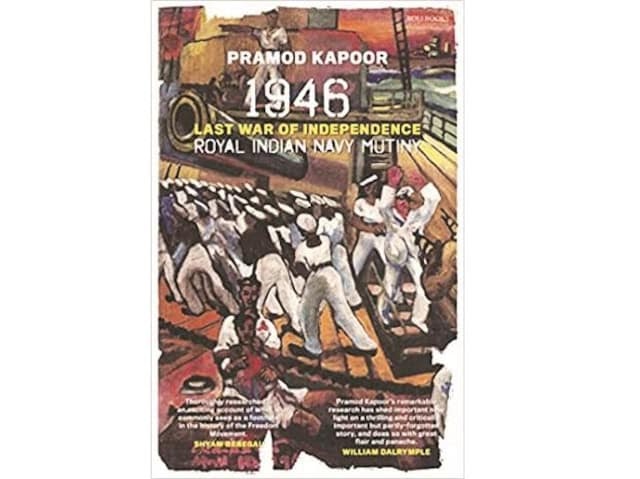
1946: Last war of independence: mutiny of the Royal Indian Navy
By Pramod Kapoor
Roli Books: New Delhi
350pages
February 18 marked the 76and anniversary of the Royal Indian Navy (RIN) Sailors’ Mutiny, an event long overlooked in modern Indian history. However, like the role of the Indian National Army (INA), it is now belatedly recognized as having contributed to India’s freedom struggle as effectively as the 1930 Salt March or the Quit India Movement. of 1942.
In this book, Pramod Kapoor, the well-known publisher of Roli Books, highlights the uprising of young RIN sailors, some as young as 16, to protest against “broken promises at the time of recruitment, horrible living conditions, unpleasant food and heinous racial discrimination. However, there was another major factor: the mutineer sailors were politically inspired by the increasingly visible role played by the Indian National Army (INA). After the end of World War II, trials began against INA officers and men, and like INA soldiers, many naval ratings were eager to fulfill their role in achieving freedom for India. The RIN mutiny paved the way for this goal.
A striking aspect of the RIN mutiny was that Indian naval officers did not support the notes and remained loyal to the navy. Therefore, the uprising was almost entirely by enlisted ratings or ranks, the majority of whom were World War II veterans, capable enough to organize the uprising and attract the support of their peers. Within 48 hours of the start of the uprising, 20,000 sailors had taken control of dozens of warships and shore establishments and presented a charter of demands. And, in an ominous omen for the British raj, the sailors quickly attracted sympathy. They were soon joined by civilians from all over India and by their military colleagues from the army and air force.
However, most of the political class openly criticized the mutineers. While young Congress workers, including Jayaprakash Narayan, Ram Manohar Lohia, Acharya Narendra Dev and Aruna Asaf Ali, supported the mutineers, Congress and Muslim League leaders were deeply alarmed, in some cases as much as the British. Sardar Patel and Jawaharlal Nehru were in cordial disagreement on how to deal with the rebels. Patel, one of the most influential Congress Party leaders, condemned the uprisings from the hearings, calling them “nothing but hooliganism”. Mahatma Gandhi, true to his credo of non-violence, publicly denounced the rebel sailors in a bitter public exchange with Aruna Asaf Ali.
The revolt was short-lived in the face of British might and cunning. Street battles broke out in Bombay and Karachi and the British were forced to call in white troops as the Indian soldiers did not want to fire on their comrades. Although the mutiny was short-lived, Mr Kapoor says the British quickly concluded it marked a major turning point: never again would the British be able to rely on Indian troops to put down an insurrection. It was nothing short of a disaster, given the centrality of the Indian military in British control of their Asian colonies. Mr Kapoor’s exploration of British archives leads him to conclude that the RIN mutiny accelerated India’s scramble for freedom, which occurred about a year and a half later.
One of the most striking aspects of the mutiny turns out to be the reaction of Indian politicians and political parties to what seems increasingly clear: that independence could be achieved through revolt rather than non- violence. Both the Congress Party and the Muslim League persuaded the mutineers to surrender. Among the rebels, there was complete harmony and unity between Muslims and Hindus. Mr Kapoor believes, based on his research, interviews with family members of the main mutineers and newspaper records, that the partition would have been much less bloody if the political leaders of the time had tried to s build on the community friendship the mutiny engendered, rather than ignore it. However, for Congress, which had driven the liberation movement for nearly half a century to the point where independence seemed imminent, this new dynamic rocked the boat unacceptably.
The distrust with which the post-independence governments of India and Pakistan treated the mutineers told its own story. Congress and the ruling Muslim League elite refused to recognize the rebels as freedom fighters or grant them government jobs. When, in the 1960s, revisionist writers wrote plays portraying the rebels as nationalist heroes, the governments of the day obstructed public performances in every possible way.
Kapoor’s central theme is summed up in one paragraph: “Instead of being inscribed in public memory alongside the Salt March, Jallianwala Bagh, etc., the naval mutiny of 1946 tends to be relegated to a mere footnote footnotes, except in scholarly works written by historians. , for the benefit of other historians. Hopefully this long overdue work will do something to give recognition to these long ignored heroes of the freedom struggle.






